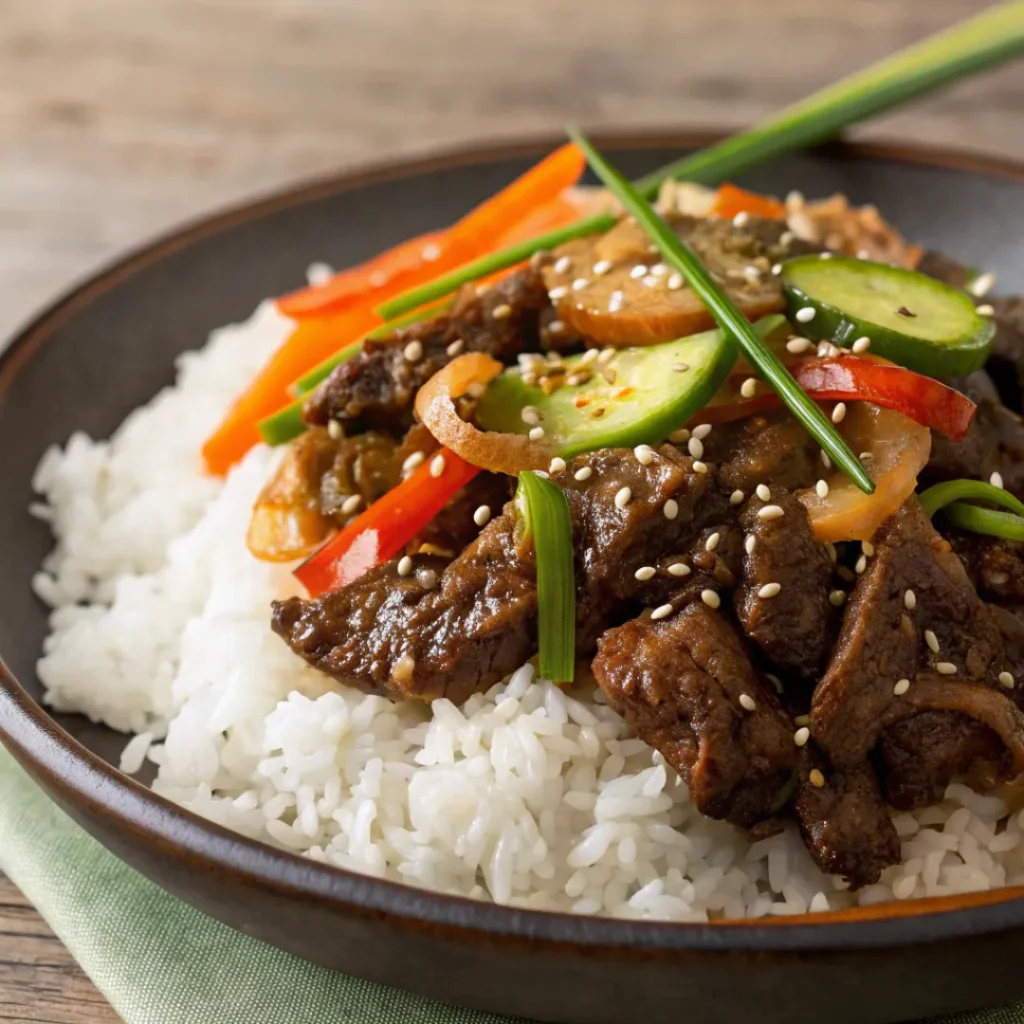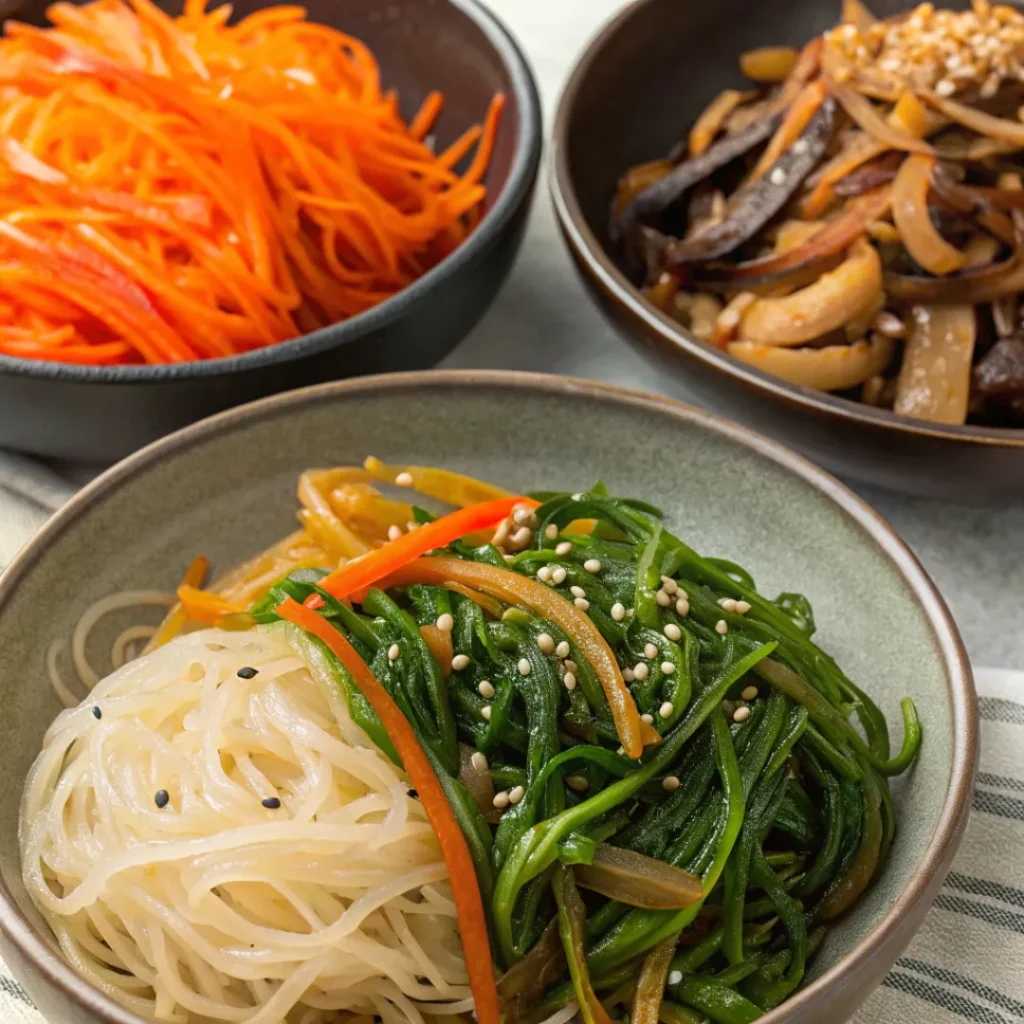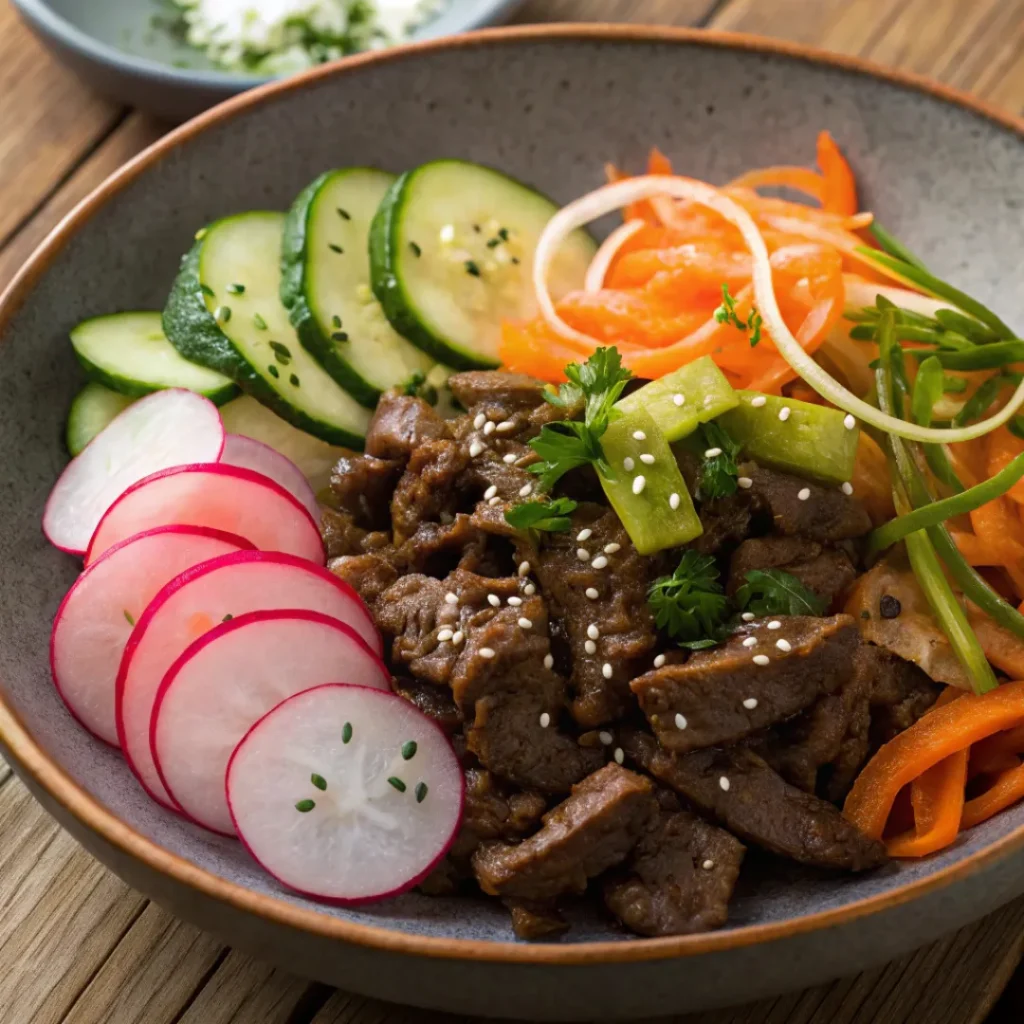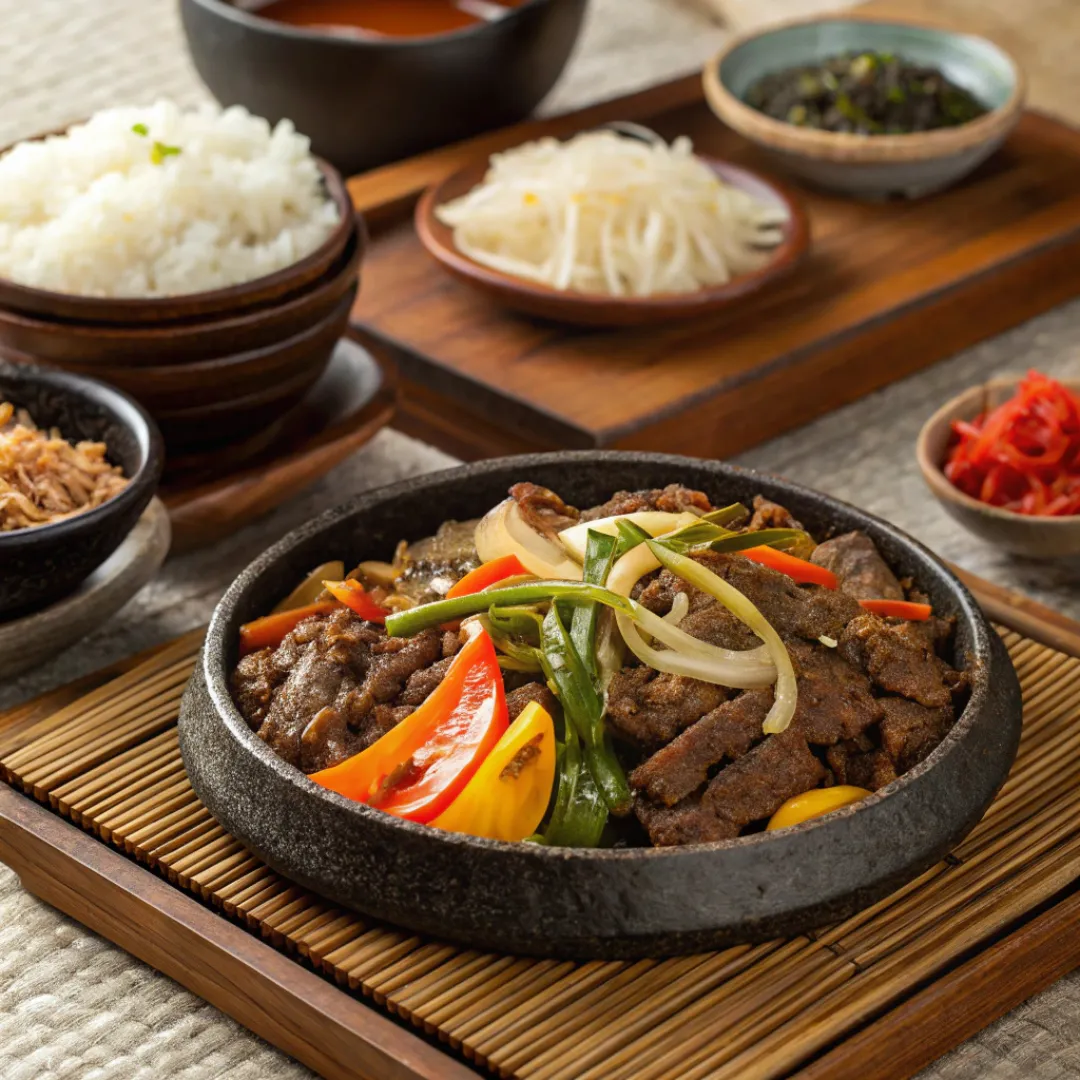Beef bulgogi is undoubtedly one of Korea’s most famous and beloved dishes. First, it’s made with thinly sliced beef marinated in a delicious mixture of soy sauce, garlic, sesame oil, and other flavorful ingredients. Next, the beef is grilled or stir-fried to perfection. As a result, you get tender, savory-sweet meat that melts in your mouth. However, enjoying beef bulgogi isn’t just about the meat alone. In order to fully appreciate this dish, it’s essential to know what to eat beef bulgogi with, as it is typically served alongside a variety of complementary sides and accompaniments. To learn more about its origins, check out the History of Bulgogi for insights into how this iconic dish became a staple in Korean cuisine.
In this article, we’ll explore the best side dishes, vegetables, and rice varieties that pair well with beef bulgogi. From traditional Korean banchan to modern twists, you’ll discover how to create a delicious and balanced dining experience.
What Do You Eat Beef Bulgogi With? Steamed Rice Complements the Dish
At the core of any traditional Korean meal, including one with beef bulgogi, is steamed rice. So, what pairs well with beef bulgogi? Rice is an obvious answer. It’s the neutral, yet perfect base for soaking up the savory marinade of the meat, making it an essential part of your bulgogi meal.

Why White Rice Complements Beef Bulgogi
Absorbs the sauce
The juices from the bulgogi marinate the rice, enriching each bite with additional flavor.
Neutral flavor
Its mild taste contrasts beautifully with the rich, flavorful beef, enhancing the overall balance.
Traditional staple
Rice is a fundamental part of Korean cuisine, making it the go-to choice with many meals, including bulgogi.
For a slightly more elevated version, you can substitute white rice with jasmine rice or short-grain rice. These options are slightly more aromatic and sticky, which makes them perfect for grabbing bites of bulgogi and rice together with chopsticks.
What to Eat Beef Bulgogi With? Classic Korean Side Dishes (Banchan)
When wondering what to eat with beef bulgogi, you can’t forget banchan, the small Korean side dishes. Classic sides like kimchi and japchae bring balance and contrast to the meal, enhancing the rich flavors of the bulgogi.
Why Kimchi Is a Great Pairing
Tangy and spicy contrast
The acidity of the fermented cabbage cuts through the rich flavors of the beef, creating a balanced bite.
Cleanses the palate
Kimchi refreshes the palate between bites of flavorful bulgogi, keeping each mouthful exciting.
Health benefits
As a fermented food, kimchi is rich in probiotics, which aid digestion, particularly when eating rich or fatty dishes like bulgogi.
There are various types of kimchi to try, but napa cabbage kimchi is the most popular choice with beef bulgogi. Its crunchy texture and bold flavor make it a perfect complement to the tender beef.
Lettuce Wraps and Ssamjang
If you’re curious about what to eat beef bulgogi with, Korean lettuce wraps are another great choice. Wrapping the flavorful beef in fresh lettuce leaves and dipping it into ssamjang offers a light and refreshing way to enjoy bulgogi.
How to Enjoy Beef Bulgogi in Lettuce Wraps:
- First, start with a large lettuce leaf (such as romaine or green leaf lettuce).
- Next, place a slice of bulgogi in the center.
- Then, add a small spoonful of steamed rice and a dollop of ssamjang (a Korean dipping sauce made from fermented soybeans and chili paste) or gochujang for an extra kick of spice.
- Finally, fold the lettuce around the filling and eat it in one bite.
Lettuce wraps are a healthy, low-carb option that provides a burst of freshness with each bite. Additionally, you can include thinly sliced cucumbers or radishes inside the wrap for added crunch.
What Complements Beef Bulgogi? Pickled Vegetables and Tangy Sides
Banchan refers to the small side dishes traditionally served with Korean meals, and they’re a key part of the beef bulgogi experience. These sides provide a variety of flavors and textures that enhance the main dish. Here are a few popular banchan options that pair perfectly with beef bulgogi:

Japchae (Korean Glass Noodles)
Japchae is a dish made from sweet potato starch noodles stir-fried with vegetables like carrots, spinach, mushrooms, and onions. Its slightly sweet flavor and chewy texture provide a nice contrast to the savory beef bulgogi. Often served cold or at room temperature, japchae is a great light side dish to accompany the rich beef.
Kongnamul (Seasoned Soybean Sprouts)
Kongnamul is a refreshing and light side dish made from seasoned soybean sprouts. It’s seasoned with sesame oil, garlic, and soy sauce, giving it a savory taste that complements the bold flavors of bulgogi. The crunch of the sprouts contrasts nicely with the tender beef, making each bite more interesting.
Sigumchi Namul (Seasoned Spinach)
Another classic banchan is sigumchi namul, which consists of blanched spinach seasoned with sesame oil, soy sauce, and garlic. The mild flavor and soft texture of the spinach pair well with beef bulgogi, adding a nutritious and flavorful green element to the meal.
What to Eat with Beef Bulgogi
When considering what complements beef bulgogi, pickled vegetables, or jangajji, provide a tangy contrast to the beef’s richness. These pickled sides not only add texture but also refresh the palate, making them a fantastic choice when deciding what to eat with bulgogi for a balanced and flavorful meal.
Pickling vegetables like radishes, cucumbers, and carrots in soy sauce, sugar, and vinegar creates a sweet, tangy, and crunchy side that pairs well with bulgogi.

Why Pickled Vegetables Work So Well:
- Tangy and refreshing: The acidity of the pickles cuts through the fattiness of the beef, offering a crisp bite that refreshes the palate.
- Textural contrast: The crunch of the pickled vegetables adds texture to the tender beef, creating a more enjoyable eating experience.
Pickled vegetables add balance to the meal and can be enjoyed alongside every bite of bulgogi, enhancing its flavors without overpowering them.
Gyeranjjim (Steamed Egg Custard)
For something warm and comforting, try gyeranjjim, a light and fluffy steamed egg custard. This dish is made by whisking eggs with water or broth and gently steaming them until they form a soft, soufflé-like texture. Gyeranjjim is typically seasoned with salt, sesame oil, and green onions, making it a mild yet flavorful side dish.
Why Gyeranjjim Complements Beef Bulgogi:
Soft texture:
The creamy, custard-like consistency contrasts with the chewy texture of the beef.
Mild flavor:
Its delicate taste doesn’t compete with the bold flavors of bulgogi, making it a perfect neutral side.
Comfort food:
Gyeranjjim is often enjoyed for its warm, comforting qualities, balancing the intense flavors of the main dish.
Gyeranjjim is traditionally served in a hot stone bowl, which keeps the custard warm throughout the meal, making it a comforting side to enjoy alongside beef bulgogi.
Vegetable Pancakes (Jeon)
Another delightful addition to a beef bulgogi meal is jeon, or Korean-style vegetable pancakes. These savory pancakes are made from a batter of flour and eggs mixed with thinly sliced vegetables like zucchini, carrots, and green onions. Pan-fried until golden and crispy, jeon adds a crunchy element to the meal and pairs wonderfully with bulgogi.
Popular Jeon Varieties to Try:
- Pajeon: A green onion pancake with a crispy exterior and tender inside.
- Kimchi Jeon: Made with chopped kimchi for a spicy kick, complementing the sweetness of bulgogi.
- Yachaejeon: A mixed vegetable pancake that’s light and full of fresh flavors.
Jeon can be enjoyed dipped in a simple soy sauce-based dipping sauce, which adds a salty, tangy element to the pancake’s crispy texture.
Ssamjang: The Ultimate Dipping Sauce
While the beef bulgogi itself is packed with flavor, a good dipping sauce can enhance the eating experience even further. Ssamjang is the go-to dipping sauce in Korea, often enjoyed with bulgogi in lettuce wraps.
What Is Ssamjang?
Ssamjang is a thick, savory, and slightly spicy sauce made from fermented soybeans (doenjang), red chili paste (gochujang), sesame oil, garlic, and green onions. The combination of these ingredients creates a robust, umami-rich sauce that pairs perfectly with the beef’s savory-sweet flavors.
Simply dip a bite of beef bulgogi into the sauce or drizzle a little over a lettuce wrap for an extra layer of flavor.
Seaweed Salad (Miyeok Muchim)
If you’re looking for something light and refreshing to pair with beef bulgogi, a seaweed salad is a great option. Miyeok muchim is made from rehydrated seaweed tossed with soy sauce, sesame oil, garlic, and vinegar, creating a tangy and savory side dish that complements the bold flavors of the beef.
Why Seaweed Salad Pairs Well with Bulgogi
Refreshing flavor
The tangy, vinegary dressing contrasts with the rich, savory bulgogi.
Nutritional benefits
Seaweed is packed with essential nutrients like iodine and calcium, adding a healthy component to your meal.
Textural contrast
The chewy texture of the seaweed complements the tender beef, creating a satisfying mouthfeel.
Seaweed salad is light yet flavorful, making it a refreshing addition to a bulgogi-based meal.
Rice Paper Rolls (Bulgogi Wraps)
For a modern twist, consider serving beef bulgogi in rice paper rolls. Inspired by Korean and Vietnamese cuisine, these wraps are made using rice paper sheets filled with bulgogi, fresh vegetables (like cucumbers, carrots, and lettuce), and sometimes vermicelli noodles.
How to Make Bulgogi Rice Paper Rolls:
- Soak rice paper sheets in warm water until they soften.
- Place a slice or two of bulgogi in the center of the sheet.
- Add thinly sliced vegetables, rice, or noodles.
- Roll the rice paper around the fillings like a burrito and enjoy with dipping sauces like ssamjang or soy sauce.
These rolls offer a refreshing and light way to enjoy bulgogi, making them a perfect option for a summer meal or a creative appetizer.
Frequently Asked Questions
What sides pair well with beef bulgogi?
Beef bulgogi pairs perfectly with traditional Korean sides like steamed white rice, kimchi, lettuce wraps (ssam), and banchan such as japchae (Korean glass noodles) and pickled vegetables. These sides balance the savory-sweet flavors and enhance the meal.
Can I eat beef bulgogi without rice?
Yes, you can enjoy beef bulgogi without rice. Many people prefer wrapping it in fresh lettuce leaves or pairing it with vegetable pancakes (jeon) or pickled vegetables (jangajji) for a lighter option.
Do people typically eat beef bulgogi with sauce?
Yes, people often enjoy beef bulgogi with ssamjang, a savory and slightly spicy Korean dipping sauce. You can also add gochujang (a red chili paste) for extra heat.
What type of rice goes best with beef bulgogi?
Steamed white rice is the most common choice, but jasmine rice or short-grain rice also work well. Their slightly sticky texture makes them perfect for pairing with bulgogi and absorbing its flavorful juices.
Can I pair beef bulgogi with modern dishes?
Yes, you can pair beef bulgogi with modern dishes like rice paper rolls, salads, or even use it as a filling for tacos or burritos. These creative options offer a fresh twist on the classic dish.
Conclusion
So, what do you eat beef bulgogi with? The possibilities are endless, whether you opt for rice, lettuce wraps, or a variety of Korean banchan. Next time you prepare bulgogi, consider adding these sides to create a complete, delicious meal.
Additionally, by combining beef bulgogi with the right sides, such as kimchi, lettuce wraps, gyeranjjim, and pickled vegetables, you can create a balanced and satisfying meal that highlights the best of Korean cuisine. Therefore, the next time you prepare beef bulgogi, try experimenting with some of these pairings to further elevate your dining experience.

